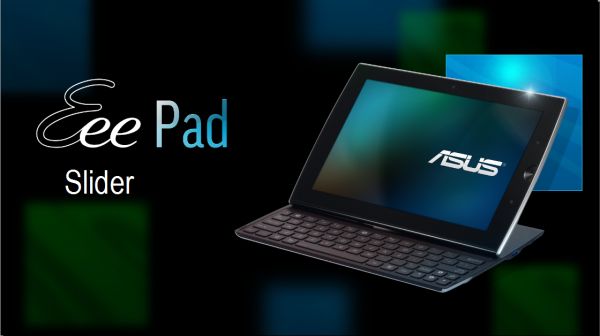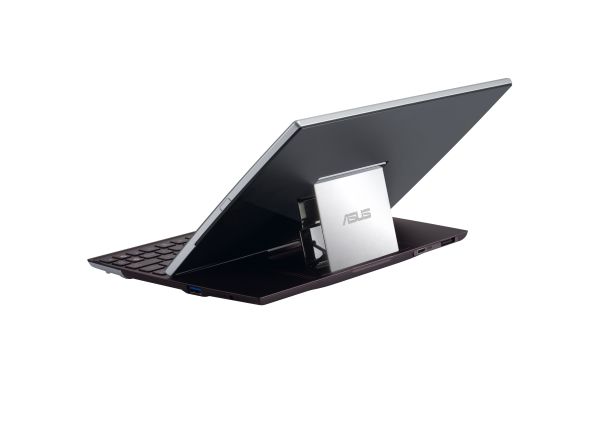ASUS Announces Eee Pad and Eee Slate Tablets
by Vivek Gowri on January 4, 2011 5:42 PM EST
The Slider is the quirky one in the family. It’s a convertible tablet of sorts, with the screen sliding and tilting to reveal a netbook-sized keyboard. The specs are identical to the Transformer (the slides indicate there is optional 3G here), though the 64GB option is sadly missing. What this means is you get Tegra 2, Honeycomb, 512MB/1GB RAM, 16/32GB flash storage, a 10.1” IPS WXGA panel with capacitive touch, and two cameras (1.2MP front, 5MP back, no flash). The base price is $499, one hundred more than the base Transformer slate (sans keyboard dock), and it’ll ship in Q2 alongside the Transformer.
I’ll be honest, I’m pretty much head over heels for the tablet slider form factor. Intel released a concept notebook at IDF 2008, called the UrbanMax, with the same basic design premise as the Slider, and I fell in love with the idea then. Now that was a Wintel system, so even though I’m thrilled to see a production tablet with the same form factor, I have my doubts.
I don’t know how useful it’ll be to have a full keyboard with Android, since the OS isn’t built for use with a keyboard and mouse like Windows is. It’s worth noting that the Slider doesn’t have a mouse, but that just makes it more awkward to control the OS (reaching over the keyboard to touch the screen, etc). It seems like it’d be similar to the iPad keyboard dock, except more portable and always attached. If you’re a keyboard junkie, that’s awesome news. If you’re not, this is basically a pointless device.
But even if you are someone who writes a lot, I’m not too sure that the Slider is as attractive as the Transformer with the mobile docking station (what ASUS is calling the netbook-style keyboard dock). The Transformer is more modular, so you can leave the keyboard behind when you don’t need it and save the extra bulk, but perhaps more importantly, it has a lot more battery life. See, the Slider is rated for 6 hours of battery life. This is undoubtedly a problem—even ASUS’ Core i3/i5 ultraportables are getting more life than that. The Transformer is rated for 8 hours, while the mobile dock is good for another 8 (totaling 16 hours of battery life, for those of you keeping score at home). And the Transformer + mobile dock combo should be priced similarly to the Slider too. On paper, while the Slider seems like a cool form factor, there doesn't appear to be a compelling reason to choose it over the Transformer, no matter what your use case is.












37 Comments
View All Comments
vol7ron - Tuesday, January 4, 2011 - link
As with all things computing, the success hinders on options and price. They have to give enough of the former and reduce enough of the later.True belief: pad/netbook devices need a smaller profit margin.
michael2k - Tuesday, January 4, 2011 - link
The high profit margin is the only reason that anyone is entering the market. Without the high profit margin, no one would introduce a single, let alone four, products.Let the early adopters pay the high margin if that is what concerns you.
MobiusStrip - Wednesday, January 5, 2011 - link
GPS. EVERY tablet should have GPS. Tablets are little more than a gimmick, but the addition of GPS would add solid value at very little cost to the manufacturer. Not to mention beating Apple, which irritatingly omitted GPS from half the iPads.Any vendor that fails to take this obvious step doesn't deserve your dollars, and their products aren't going to be around long anyway.
tipoo - Tuesday, January 4, 2011 - link
On the spec sheet next to battery life they probably just write "No".JarredWalton - Tuesday, January 4, 2011 - link
Except we got pretty good battery life from the ASUS U30Jc, and the UL80Jt, and.... It will depend on how big the battery is, but the i5-470UM ought to be able to hit at least five hours on a ~30Wh battery.VivekGowri - Tuesday, January 4, 2011 - link
Yeah, they didn't actually mention battery life, indicating that it's probably not very good.....Unfortunate, but it's a reality. I think Windows slates are going to be doomed to mediocre battery life - Intel chips aren't low-power enough for tablets (yet). That'll change with Moorestown and Oak Trail, but right now they just can't compete with ARM as far as handheld battery life.halcyon - Wednesday, January 5, 2011 - link
Well, Asus pretty much wrote "no" in the specs of Eee Slate EP121:Battery life: up to 3 hours (under specific conditions, which you can easily guess what those are)
In real life usage that is going to mean less than 2 hours of battery life.
If that is not a FAIL for a tablet, I don't know what is.
tipoo - Wednesday, January 5, 2011 - link
Yeah, three hours is what I would consider bad in a laptop, let alone a tablet.headbox - Tuesday, January 4, 2011 - link
I predict Zune-like sales if they're lucky.bplewis24 - Tuesday, January 4, 2011 - link
Anybody else find it interesting that Asus is going with IPS displays across the board here when they generally do not use IPS displays in their mainstream desktop monitor line of products?Does this signify a shift in focus that will carry over to their desktop monitors or will it be exclusive to their tablet/slate product line?
Brandon